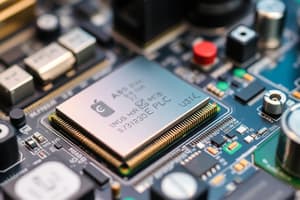Podcast
Questions and Answers
Match the storage device to its primary characteristic:
Match the storage device to its primary characteristic:
Hard Disk Drive (HDD) = Mechanical storage with spinning disks. Solid State Drive (SSD) = Electronic storage with faster access times. Flash Drive = Portable storage using flash memory. RAM = Volatile memory used for active data.
Match the operating system with its typical device:
Match the operating system with its typical device:
Windows = Desktop and laptop computers macOS = Apple Macintosh computers Android = Smartphones and tablets Linux = Servers and embedded systems
Match the threat with its corresponding prevention method:
Match the threat with its corresponding prevention method:
Malware = Install and regularly update antivirus software. Phishing = Verify the legitimacy of email senders and website URLs. Unauthorized Access = Use strong, unique passwords and multi-factor authentication. Data Breach = Encrypt sensitive data and implement access controls.
Match the following software to its function:
Match the following software to its function:
Match the file extension to its corresponding file type:
Match the file extension to its corresponding file type:
Match the input device to its primary function:
Match the input device to its primary function:
Match the type of computer network with its scale:
Match the type of computer network with its scale:
Match the CPU component to its function:
Match the CPU component to its function:
Match the utility program to its function:
Match the utility program to its function:
Match the term to its description in computer security:
Match the term to its description in computer security:
Match the component with its role in data processing:
Match the component with its role in data processing:
Match the cloud computing service model with its function:
Match the cloud computing service model with its function:
Match the system with its use case:
Match the system with its use case:
Match the type of server with its function:
Match the type of server with its function:
Match the Internet Protocol with its description:
Match the Internet Protocol with its description:
Flashcards
What is Hardware?
What is Hardware?
Physical parts of a computer you can touch.
What is the CPU?
What is the CPU?
The 'brain' of the computer; processes instructions.
What is RAM?
What is RAM?
Short-term memory for active data; lost when powered off.
What is Storage?
What is Storage?
Signup and view all the flashcards
What are Input Devices?
What are Input Devices?
Signup and view all the flashcards
What are Output Devices?
What are Output Devices?
Signup and view all the flashcards
What is Software?
What is Software?
Signup and view all the flashcards
What is System Software?
What is System Software?
Signup and view all the flashcards
What is Application Software?
What is Application Software?
Signup and view all the flashcards
What is an Operating System?
What is an Operating System?
Signup and view all the flashcards
What is Computer Processing?
What is Computer Processing?
Signup and view all the flashcards
What is a Computer Network?
What is a Computer Network?
Signup and view all the flashcards
What is Computer Security?
What is Computer Security?
Signup and view all the flashcards
What are Device Drivers?
What are Device Drivers?
Signup and view all the flashcards
What is an SSD?
What is an SSD?
Signup and view all the flashcards
Study Notes
- ระบบคอมพิวเตอร์ประกอบด้วยส่วนประกอบที่ทำงานร่วมกันเพื่อประมวลผลข้อมูลและสร้างผลลัพธ์
- ส่วนประกอบหลักของระบบคอมพิวเตอร์ ได้แก่ ฮาร์ดแวร์และซอฟต์แวร์
ฮาร์ดแวร์
- ฮาร์ดแวร์ คือ ส่วนประกอบทางกายภาพของคอมพิวเตอร์ที่สามารถจับต้องได้
- ประกอบด้วยอุปกรณ์ต่างๆ เช่น หน่วยประมวลผลกลาง (CPU), หน่วยความจำ (Memory), อุปกรณ์จัดเก็บข้อมูล (Storage Devices), อุปกรณ์นำเข้า (Input Devices) และอุปกรณ์แสดงผล (Output Devices)
หน่วยประมวลผลกลาง (CPU)
- CPU ทำหน้าที่เป็นสมองของคอมพิวเตอร์ ควบคุมการทำงานของอุปกรณ์ต่างๆ และประมวลผลข้อมูลตามคำสั่ง
- ความเร็วของ CPU มีผลต่อประสิทธิภาพโดยรวมของคอมพิวเตอร์
- ผู้ผลิต CPU รายใหญ่ ได้แก่ Intel และ AMD
หน่วยความจำ (Memory)
- หน่วยความจำหลัก (RAM) ใช้เก็บข้อมูลและโปรแกรมที่ CPU กำลังใช้งานอยู่
- RAM มีความเร็วในการเข้าถึงข้อมูลสูง แต่ข้อมูลจะหายไปเมื่อปิดเครื่อง
- หน่วยความจำรอง เช่น ฮาร์ดดิสก์ SSD และ Flash Drive ใช้เก็บข้อมูลถาวร
- ROM (Read-Only Memory) เป็นหน่วยความจำที่เก็บข้อมูลที่จำเป็นสำหรับการเริ่มต้นระบบ
อุปกรณ์จัดเก็บข้อมูล (Storage Devices)
- ฮาร์ดดิสก์ (HDD) เป็นอุปกรณ์จัดเก็บข้อมูลแบบจานหมุน มีความจุสูง แต่ความเร็วในการเข้าถึงข้อมูลต่ำกว่า SSD
- โซลิดสเตตไดรฟ์ (SSD) เป็นอุปกรณ์จัดเก็บข้อมูลแบบอิเล็กทรอนิกส์ มีความเร็วในการเข้าถึงข้อมูลสูงกว่า HDD และทนทานกว่า
- Flash Drive เป็นอุปกรณ์จัดเก็บข้อมูลแบบพกพา ใช้หน่วยความจำ Flash ในการจัดเก็บข้อมูล
อุปกรณ์นำเข้า (Input Devices)
- อุปกรณ์นำเข้าใช้สำหรับป้อนข้อมูลเข้าสู่คอมพิวเตอร์
- ตัวอย่างอุปกรณ์นำเข้า ได้แก่ คีย์บอร์ด เมาส์ สแกนเนอร์ และไมโครโฟน
อุปกรณ์แสดงผล (Output Devices)
- อุปกรณ์แสดงผลใช้สำหรับแสดงผลข้อมูลจากคอมพิวเตอร์
- ตัวอย่างอุปกรณ์แสดงผล ได้แก่ จอภาพ เครื่องพิมพ์ และลำโพง
ซอฟต์แวร์
- ซอฟต์แวร์ คือ ชุดคำสั่งหรือโปรแกรมที่สั่งให้ฮาร์ดแวร์ทำงาน
- แบ่งออกเป็น 2 ประเภทหลัก คือ ซอฟต์แวร์ระบบและซอฟต์แวร์ประยุกต์
ซอฟต์แวร์ระบบ (System Software)
- ซอฟต์แวร์ระบบทำหน้าที่จัดการและควบคุมการทำงานของฮาร์ดแวร์และทรัพยากรต่างๆ ของระบบคอมพิวเตอร์
- ระบบปฏิบัติการ (Operating System: OS) เป็นซอฟต์แวร์ระบบที่สำคัญที่สุด ทำหน้าที่เป็นตัวกลางระหว่างฮาร์ดแวร์และซอฟต์แวร์ประยุกต์
- ตัวอย่างระบบปฏิบัติการ ได้แก่ Windows, macOS, Linux, Android และ iOS
- โปรแกรมอรรถประโยชน์ (Utility Programs) เป็นซอฟต์แวร์ระบบที่ช่วยในการจัดการและบำรุงรักษาระบบคอมพิวเตอร์
- ตัวอย่างโปรแกรมอรรถประโยชน์ ได้แก่ โปรแกรมจัดการไฟล์ โปรแกรมสแกนไวรัส และโปรแกรมบีบอัดไฟล์
- โปรแกรมขับอุปกรณ์ (Device Drivers) เป็นซอฟต์แวร์ที่ช่วยให้ระบบปฏิบัติการสามารถสื่อสารและควบคุมอุปกรณ์ฮาร์ดแวร์ต่างๆ ได้
ซอฟต์แวร์ประยุกต์ (Application Software)
- ซอฟต์แวร์ประยุกต์เป็นซอฟต์แวร์ที่ออกแบบมาเพื่อตอบสนองความต้องการของผู้ใช้ในด้านต่างๆ
- ตัวอย่างซอฟต์แวร์ประยุกต์ ได้แก่ โปรแกรมประมวลผลคำ (Microsoft Word), โปรแกรมตารางคำนวณ (Microsoft Excel), โปรแกรมนำเสนอ (Microsoft PowerPoint), โปรแกรมจัดการฐานข้อมูล (Microsoft Access), เว็บเบราว์เซอร์ (Google Chrome, Mozilla Firefox) และเกมคอมพิวเตอร์
การทำงานของระบบคอมพิวเตอร์
- ระบบคอมพิวเตอร์ทำงานโดยรับข้อมูลนำเข้า (Input) ประมวลผลข้อมูล (Processing) และแสดงผลลัพธ์ (Output)
- ข้อมูลนำเข้าจะถูกป้อนเข้าสู่คอมพิวเตอร์ผ่านอุปกรณ์นำเข้า
- CPU จะประมวลผลข้อมูลตามคำสั่งของซอฟต์แวร์
- ผลลัพธ์ที่ได้จากการประมวลผลจะถูกแสดงผลผ่านอุปกรณ์แสดงผล หรือจัดเก็บไว้ในอุปกรณ์จัดเก็บข้อมูล
เครือข่ายคอมพิวเตอร์
- เครือข่ายคอมพิวเตอร์ คือ กลุ่มของคอมพิวเตอร์และอุปกรณ์ต่างๆ ที่เชื่อมต่อกันเพื่อแลกเปลี่ยนข้อมูลและทรัพยากรร่วมกัน
- เครือข่ายคอมพิวเตอร์ช่วยให้ผู้ใช้สามารถแบ่งปันไฟล์ เครื่องพิมพ์ และการเชื่อมต่ออินเทอร์เน็ต
- ตัวอย่างเครือข่ายคอมพิวเตอร์ ได้แก่ เครือข่ายท้องถิ่น (LAN), เครือข่ายวงกว้าง (WAN) และอินเทอร์เน็ต
ความปลอดภัยของระบบคอมพิวเตอร์
- ความปลอดภัยของระบบคอมพิวเตอร์เป็นสิ่งสำคัญในการปกป้องข้อมูลและระบบจากการเข้าถึงโดยไม่ได้รับอนุญาต การโจมตีทางไซเบอร์ และภัยคุกคามอื่นๆ
- มาตรการรักษาความปลอดภัย ได้แก่ การใช้รหัสผ่านที่แข็งแกร่ง การติดตั้งโปรแกรมป้องกันไวรัส การสำรองข้อมูล และการอัปเดตซอฟต์แวร์อย่างสม่ำเสมอ
Studying That Suits You
Use AI to generate personalized quizzes and flashcards to suit your learning preferences.
Description
A computer system consists of hardware and software. Hardware includes CPU, memory, storage, input, and output devices. The CPU processes data, memory stores active data, and storage devices store permanent data.




